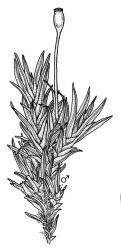- = Fissidens arcuatulus Broth. & Watts, Proc. Linn. Soc. New South Wales 40: 368 (1915)
- ≡ Fissidens aeruginosus var. arcuatulus (Broth. & Watts) I.G.Stone, J. Bryol. 16: 238 (1990) nom. illeg.
- = Fissidens allisonii Dixon & Sainsbury, J. Bot. 71: 216 (1933)
- ≡ Fissidens humilis var. allisonii (Dixon & Sainsbury) Sainsbury, Rev. Bryol. Lichénol., n.s. 21: 214 (1952)
- ≡ Fissidens aeruginosus var. allisonii (Dixon & Sainsbury) I.G.Stone, J. Bryol. 18: 163 (1994)
Plants 1.5–5.0 mm, dull green, densely gregarious. Stems simple or branched, with rhizoids at base of stems or branches, and on prostrate stems where in contact with soil. Leaves in 3–15(–20) pairs, overlapping at mid stem, erect-spreading, slightly decurved when moist, decurved when dry, oblong-lanceolate (var. linearis) or linear (var. angustifolius), 0.8–1.4 × 0.1–0.3 mm; apex acute (var. linearis) or narrowly acute (var. angustifolius); laminae unistratose; vaginant laminae partially closed; dorsal lamina failing shortly above or reaching the leaf insertion, tapered to its base; margins crenulate, papillose; cells of apical and dorsal laminae isodiametric, quadrate to hexagonal, multipapillose, slightly bulging, with moderately thick walls, (5.0–)6.0–9.0(–10.5) × (5.0–)6.0–9.0(–10.5) µm. Costa subpercurrent to percurrent, usually with a hyaline and elongate terminal cell, bryoides-type in cross-section.
Sexuality various. Perichaetial leaves little differentiated from vegetative in shape, proximal region of vaginant laminae bordered with 2–3 rows of smooth hyaline rectangular cells. Perigonia as per varieties. Setae yellow to light brown, stiff, 1.0–2.5 mm; capsules erect, symmetric, 0.5–0.7 mm; operculum obliquely rostrate from a conic base, ⅔ to equal the length of theca. Peristome scariosus-type, teeth 30–38 µm wide at base. Calyptra smooth to scabrous, cucullate. Spores 8–18 µm.
| Category | Number |
|---|---|
| Indigenous (Endemic) | 1 |
| Indigenous (Non-endemic) | 1 |
| Total | 2 |




